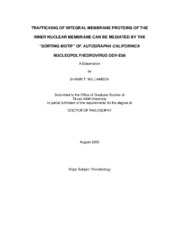| dc.description.abstract | The amino-terminal 33 amino acids of the baculovirus integral membrane
protein, ODV-E66, are sufficient for localization of fusion proteins to viralinduced
intranuclear microvesicles (MV) and occlusion derived virus envelopes
during infection, and has been termed the sorting motif (SM). When abundantly
expressed, SM-fusions are also detected in the inner nuclear membrane (INM),
outer nuclear membrane and endoplasmic reticulum of infected cells, suggesting
proteins with the SM use the same trafficking pathway as cellular INM proteins
to traffic to nuclear membranes. This study identifies the essential
characteristics required for sorting of the SM to the INM of uninfected cells, and
the MV and ODV envelopes of infected cells. These features are an 18 amino
acid transmembrane sequence that lacks polar and charged amino acids (a.a.)
with a cluster of charged a.a. spaced 5-11 residues from the end of the
transmembrane sequence. A comparison of the a.a. sequence of these SM
features with cellular INM proteins shows the features are conserved.
The model of INM protein sorting and localization predicts the only known
sorting event during INM protein trafficking is immobilization/retention in the INM. This study uses confocal microscopy and fluorescence recovery after
photobleaching to compare the localization and mobility of lamin B receptor
(LBR) fusions (which contain SM-like sequences) to a viral SM fusion when
expressed in either mammalian or insect cells. The results show that
immobilization is not necessarily required for accumulation of proteins in the
INM. Furthermore, the results from infected cells show that an active sorting
event, likely independent of immobilization, can distinguish the viral SM from
cellular sequences similar to the SM.
The results of this study show that sorting of proteins to the INM can be
mediated by the viral SM or INM protein SM-like sequences that can function
either independent of, or in addition to, immobilization. These data combined
with recent reports suggest that in addition to diffusion:retention a signal
mediated mechanism for sorting and localization to the INM can occur. | en |


